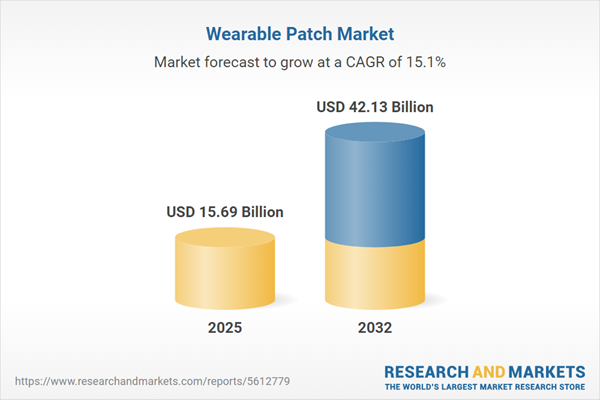Speak directly to the analyst to clarify any post sales queries you may have.
The wearable patch market is rapidly shaping the future of digital healthcare by streamlining patient-centric care and operational agility. As healthcare organizations shift towards outcome-driven delivery models, wearable patches emerge as essential tools for staying ahead in a fast-evolving digital landscape.
Market Snapshot: Wearable Patch Market Growth Overview
The global wearable patch market is currently valued at USD 13.64 billion in 2024, with growth expected to reach USD 15.69 billion by 2025. This reflects a compound annual growth rate (CAGR) of 15.13%, signifying strong and consistent expansion. Drivers of growth include advances across digital health platforms, wider integration of remote patient monitoring, and an extensive range of device functionalities. Wearable patch solutions are enabling healthcare providers to support value-based care, deliver strategic digital health initiatives, and address diverse clinical requirements across varied patient populations.
Scope & Segmentation: Strategic Focus in the Wearable Patch Market
Targeted segmentation aids healthcare organizations in aligning resources and sharpening their market position. The market’s key domains span the following areas:
- Product Types: Drug infusion patches, sensor-enabled wearables, electronic patch alternatives, and reservoir adhesive designs. These address preventive monitoring and ongoing intervention needs in clinical workflows.
- Technologies: Electroporation, iontophoresis, microneedle platforms, and ultrasound-based drug delivery. Each supports responsive care models, particularly valuable for chronic and at-risk patient populations.
- Applications: Biomarker diagnostics, drug delivery, glucose monitoring, vital sign assessment, and wound management. These enable providers to orchestrate real-time and customized patient intervention strategies.
- End Users: Hospitals, clinics, home care environments, and research organizations. Wearable patches are enhancing patient management across both acute and chronic care settings, facilitating standardized protocols and improved care coordination.
- Distribution Channels: Medical procurement pathways, retail pharmacies, and digital sales platforms work together to provide broad product access and maintain efficient supply chain operations worldwide.
- Therapeutic Areas: Cardiovascular care, oncology, pain management, and hormone regulation. These domains leverage patches for delivering specialized therapies and enabling tailored clinical pathways.
- Geographic Regions: North America, South America, Europe, Middle East, Africa, and Asia-Pacific. Countries like the US, Germany, China, Brazil, India, France, South Africa, and Japan illustrate how regulatory developments and demographic trends shape strategic market approaches.
- Leading Companies: Dexcom, Abbott Laboratories, Medtronic, VivaLNK, Insulet, iRhythm Technologies, Koninklijke Philips, LifeSignals, VitalConnect, and Epicore Biosystems set performance benchmarks and inform deployment standards in this evolving landscape.
Key Takeaways for Senior Decision-Makers
- Wearable patches support the seamless transfer of patient data between care settings, promoting continuous monitoring and helping organizations drive overall care quality improvements across diverse environments.
- Integration of advanced analytics and microneedle solutions equips clinical teams with actionable insights, enabling more adaptive and individualized approaches to patient management.
- Partnerships between device manufacturers and health systems promote successful technology adoption, resulting in streamlined processes and stronger organizational readiness for future scale and complexity.
- Maintaining compliance with connectivity and data-privacy requirements is critical as interoperability becomes more central to digital health, safeguarding patient information and reinforcing trust with key stakeholders.
- Modern design strategies and adaptive manufacturing methods allow healthcare organizations to respond promptly to shifting clinical requirements and capitalize on opportunities within dynamic health sectors.
Tariff Impact: Strategic Response to Updated Trade Frameworks
Recent changes to US tariffs affecting medical device imports are driving strategic reviews of sourcing and supply arrangements within the sector. Many industry leaders are increasing domestic and nearshore manufacturing, renegotiating supplier agreements, and diversifying their sourcing networks to reinforce stability and operational continuity. Techniques such as value engineering and focusing on performance-based contracts are also used to improve compliance and reduce risk amid ongoing uncertainty in global trade regulations.
Methodology & Data Sources
This report draws on structured secondary research, utilizing industry reports, regulatory material, and healthcare datasets. Insights have been verified through expert interviews and scenario-based analysis to ensure the reliability of guidance for digital health strategy development.
Why This Report Matters
- Comprehensive segmentation and analysis of competitors enable leaders to pinpoint risks and develop strategies tailored for growth and adaptability in the wearable patch market.
- Operational and supply chain recommendations support organizations in adapting to regulatory dynamics and mitigating future market disruption.
- Market trend analysis provides leadership teams with data-driven perspectives for prioritizing digital health investments and expanding into promising segments.
Conclusion
Wearable patch technologies are redefining the direction of digital health and strategic planning for providers and suppliers worldwide. Early adoption positions organizations to address changing care demands and deliver measurable improvements in patient outcomes as the healthcare landscape evolves.
Additional Product Information:
- Purchase of this report includes 1 year online access with quarterly updates.
- This report can be updated on request. Please contact our Customer Experience team using the Ask a Question widget on our website.
Table of Contents
3. Executive Summary
4. Market Overview
7. Cumulative Impact of Artificial Intelligence 2025
Companies Mentioned
The companies profiled in this Wearable Patch market report include:- Dexcom, Inc.
- Abbott Laboratories
- Medtronic PLC
- VivaLNK, Inc.
- Insulet Corporation
- iRhythm Technologies, Inc.
- Koninklijke Philips N.V.
- LifeSignals, Inc.
- VitalConnect, Inc.
- Epicore Biosystems, Inc.
Table Information
| Report Attribute | Details |
|---|---|
| No. of Pages | 199 |
| Published | November 2025 |
| Forecast Period | 2025 - 2032 |
| Estimated Market Value ( USD | $ 15.69 Billion |
| Forecasted Market Value ( USD | $ 42.13 Billion |
| Compound Annual Growth Rate | 15.1% |
| Regions Covered | Global |
| No. of Companies Mentioned | 11 |









